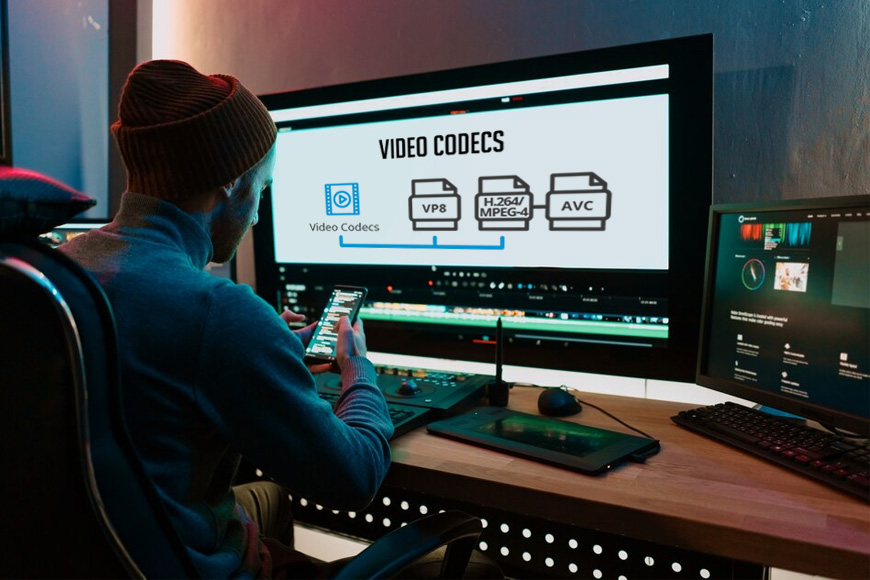Whether you’re an experienced designer or just starting out in your career, wrapping your head around the various video formats and codecs can be overwhelming. While initially a little intimidating, however, knowing how to handle visual files successfully can improve your workflow and help you get the most out of your graphic design work.
In this guide, we’ll take a look at what codecs and containers are, the importance of formatting videos correctly, and how to improve video quality by choosing the right format.
Why Video Formats Are Important
Video has long been an essential for businesses marketing their products and services, and motion graphics and animations are a perfect way to elevate promotions, reinforce brand guidelines and styles, and develop unique content that audiences really resonate with. But with that comes the issue of saving and uploading those files once they’re complete.
Video formats are the ‘containers’ which retain the data, and you’ll likely be familiar with some of the most popular formats used by MPB’s Content Creators, such as MP4, AV1 and MOV. Codecs are how the video stream is encoded and compressed, with common codecs being H.264 and H.265.
AV1 is an open-source alternative to H.265 that was developed by leading brands like Amazon, Netflix and Google, but it’s not supported on as many devices so its adoption has been limited, despite a reported 30% greater efficiency rate. Since different formats affect compatibility on different devices and platforms, knowing which format you need is critical to protect the quality of the visuals and allow for sharing.
A Deeper Dive on Codecs and Containers
Video files can get incredibly large, so codecs are responsible for compressing the data so they don’t affect load speeds. The files are encoded and decoded, then compressed to shrink the file size. This process is vital because RAW high-resolution files are so large that even just a minute’s worth of video could result in a file size of several GB. With a codec, you don’t have to worry about the file size affecting websites and other platforms, but you can also be confident that the quality won’t be lost.
Containers are the formats that wrap up the data into a neat package for uploading, storing and sharing. Think of it as the cardboard box or envelope that you might use to protect a gift or letter. Just as we have different forms of wrapping, we have different containers that will encode the video in various ways based on how it’s being used. MOV is an Apple format which is compatible with Mac and iOS platforms, while MP4 is widely supported online. AVI is less commonly used but it was once a universal PC format that you may still come across occasionally.
Formats for Different Uses

To share your edited videos, you need to adhere to the platforms’ recommended formats. YouTube and Vimeo uploads need to be in an MP4 format, while for iOS devices, you’ll need to export them into an MOV file.
For most graphic designers looking to incorporate video and motion graphics into their work, MP4 is the safest and most practical option. It’s compatible across a broad range of hardware and operating systems, ensures smooth playback within apps and browsers, and offers efficient compression without excessive quality loss. Pairing MP4 with the H.264 or H.265 codec ensures high-definition video output while keeping your file sizes manageable. However, understanding other formats ensures flexibility when handling different types of media.
However, while MP4 dominates modern usage, MOV and AVI still hold some value. As already mentioned, MOV is ideal for Apple users and can serve as an intermediate editing format while AVI, though less relevant today, supports various codecs and might be necessary if you’re working with older footage. As you progress in video editing and production, you might also come across other emerging formats like AVCHD or MXF, a professional broadcasting format that’s optimized for advanced workflows.
Handling Data Losses

When you’re editing footage, you might notice a drop in the quality. While high compression is valuable in terms of reducing the size of the file, it does mean you run the risk of a blurred or blocky picture or a loss of vibrancy in colours and details. It can require a little trial and error to strike the right balance when exporting the footage to avoid affecting the quality.
For streaming, using HD bitrates ensures smooth playback without unnecessary data use, while for sharing content online, you want to opt for smaller, mobile-friendly profiles to maintain accessibility without sacrificing too much quality. For archiving master files, it’s recommended to use the highest-quality source settings to preserve details for future use—never compress or delete original footage as you may need to return to it at a later date.
Conclusion
Mastering the art of codecs and video formats is a valuable skill for any graphic designer, whether you’re already working with motion content or want to expand your repertoire for the future. Understanding the role of codecs and containers will help in crafting high-quality visuals that are both efficient and widely compatible. Hopefully, this guide will help you make informed choices about compression settings and file formats so you can maintain the integrity of your work while ensuring seamless playback.
(Visited 23 times, 11 visits today)

